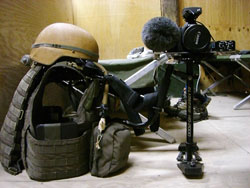
Danfung Dennis, who filmed the opening scene of Obama's War, is a freelance photojournalist who has covered Afghanistan and Iraq since 2006. He was embedded with Echo Company, 2nd Battalion, 8th Marine Company, for three weeks in early July 2009 to chronicle the beginning of Operation Strike of the Sword, a U.S.-led offensive in southern Helmand province. He is currently based in London. Watch a trailer of his upcoming film here.
How did you find the Marines' morale before they went in there?
Good, actually quite calm, very professional. I think they had been trained exactly for this kind of mission.
What was the mission?
The objective was to seize a key bridge that was crossing a canal ... and then to build a forward operating base and then to secure that area. So they were first going to clear it, then hold and then to build. ...
They could hear on their radio transmissions that the insurgents could see them, and within a few hours of landing the fighting started. It was coming from three different directions but it focused on a marketplace. The Marines pushed into the market and there was a small hill, which they later named Machine Gun Hill, where much of the battle focused.
What happened on that hill?
There wasn't much cover; you just had to try and stay as low as you could. There were rounds that were landing quite close. The Marines were trying to see where the fire was coming from and respond to it.
What was the environment like?
It was an agricultural area, so quite a few fields, a few canals and this market area had a few shops. But the fighting took place in an area with a view of some other buildings and some villages. The Marines would push up as far as they could and engage the enemy, but there was a limit to how far they could advance.
Why?
There wasn't any cover after that. It was open ground.
... Did they put up a good fight? Who won the battle?
It was a good fight for those three days. It would start sometimes in the morning, sometimes at noon and then continue sporadically throughout the day. On the first day, there was a casualty, in which the Marines were trying to hold Machine Gun Hill. One of the Marines [Lance Cpl. Charles Sharp] was shot in the neck.


So would you say [the Taliban] were pretty accurate then? These were pretty good shots?
They were quite accurate. ... They knew what they were doing.
And how would you describe the Marine reaction to those battles?
They were very controlled. They knew what they were supposed to do. They knew what positions to take and they knew where to direct their fire. But the hard part was finding where the fire was coming from.
So what do you look for? Muzzle flashes?
You can hear a lot going on but you can't really tell what direction it's coming from. So if one soldier sees where the fire is coming from, he'll tell others and then they will direct their fire at that one spot. ...
Do they call in a lot of air support? That seems to be the main advantage NATO and American forces have over the insurgency.
The commanders were initially quite concerned about this company because they were deployed so far south they were out of artillery support range. They did have air support. When they called in for support the first day, their support was denied, in fact, three times, and it wasn't until the Marine was killed that their requests were approved.
It took a Marine to die before they got any air support at all?
They had helicopters on station but they weren't engaging until after the Marine was killed. ...
Why?
The Marines were trying to be very careful about civilian casualties. They don't want to target a house [to catch a sniper] that might have an insurgent, but might also have a family.
So they were trying to distinguish between the Taliban and the population?
They were. It's very difficult to tell who is an insurgent and who is a civilian, and they know that any civilian casualties will create immense hostility towards them. So they were being very careful. ... When they do target something, ... they have positive identification on weapons.
What do you mean by positive identification?
If they see a weapon, that's positive identification, and they're clear to engage.
Did you have time to talk to them about this, the difficulty of distinguishing between an insurgent and civilian?
I did. It was very frustrating for the Marines to distinguish between a civilian and an insurgent. There'd be times when they'd come to a villager and they'd suspect he might have insurgent ties, but they could never really be sure who was a supporter, who was a spy or who was just a farmer.
So how did they try and work it out? Did they ask certain questions? ...
When the Marines first arrived, the villagers fled to the desert because they knew there would be fighting. As the fighting subsided the villagers trickled back in. There was a key market that the Marines were trying to hold, but one of the main complaints from the villagers was that they had closed roads and they had closed markets so there was no way to get supplies for the families. The Marines had closed the roads to stop the traffic passing nearby. ...
I think everything takes time and I think that's what they were trying to emphasize with the villagers, that it would take time to establish the security; it would take time bring progress. But I think there's a very narrow window of opportunity to actually win the support in the hearts and minds of villagers and that window is closing. ...
The Marines are trained to be aggressive. If they see the target they head for it. But then when they go to the villages, they need to interact with the locals and win their trust. How do they do that?
They go in with this mindset that anyone could be the enemy. When they do see a villager, they would ask them to lift up their shirts to see if they have any suicide vests on. But after that they'd try and make them friends with them. On the one hand, they're insulting the villager; on the other hand, they have to, because anyone could be an insurgent.
How are you insulting a villager?
In Afghan culture it's very rude to make someone lift up their clothes.
And what was the reaction of the villagers to this sort of interrogation?
There was one instance where the captain of the company had a meeting, the first meeting with the village elders, and he had a speech saying: "We're here to help. We're here to strengthen the Afghan government." And the first thing the village elders said [was], "We want you to leave."
What did he say back?
He was slightly stunned and had to think about it for a little while, but he said, "We're here to stay." ...
The Afghans were very hesitant to help the Marines, because they didn't know if they were here to stay. If they did help them, they could risk being killed by the Taliban.
Were they receiving intimidation from the Taliban in dealing with the Americans?
The Taliban had a very strong presence in this area and they had a shadow government. They were in control before the Marines arrived. ...
Did you see any Taliban in Helmand?
I didn't personally see any Taliban. The Marines say it is very much like fighting a ghost. They're very difficult to see, and even if they did actually kill or injure one of the Taliban, there were never any bodies. ...
Are locals equally afraid of the Taliban and the Americans?
The Afghan people are very much stuck between the Taliban and the Marines. They're not quite sure who they support yet. ... They're waiting to see who is the stronger force, and they're not actually going to help either side until they see that. ...
Was the mission a success from what you saw?
It was too early to say. They did establish a small outpost, and they did control some of the surrounding areas, but the areas that they did control [were] quite limited. They had a few outposts, but within probably one kilometer in every direction there were roadside bombs planted. So anywhere you travel there'd be explosions. So it was very difficult for re-supply to come to this location for reinforcements. Everything came by the air, because the roads were so filled with IEDs. ...
Tell me about the conditions in which you were fighting.
The conditions were very difficult. It was extremely hot, unbearably hot, very dusty. On our first day, there were multiple heat casualties.
How many?
I actually can't remember, because it seems like people were dropping and passing out. One person was medevaced back to the U.S. because his temperature was so high that he had possible brain damage.
You saw them just dropping?
Yes.
How high were the temperatures?
They were at a point where brain damage is possible. So 105 degrees and above.
That's the body temperature?
Body temperature. The actual temperature could easily have been 120 degrees. ...
How did you deal with it?
It's hard to even think when it's that hot, so you just sort of drink as much water as you can and bear it. ... No matter how much you drink, you sweat it all out immediately.
How much water were you drinking?
Easily a bottle every half hour. So in a day, eight liters of water easily.
What did you eat?
I ate these army rations, these meals ready to eat. They come in these little packets that heat up. There have like 30 different flavors, but they all have the same consistency.
And where did you sleep?
... We slept just in the dirt. In the first few days it was in a small shed and there was this fear that insurgents would come anytime from anywhere, so they rigged up these teapots to the doors with a string and so if the door opened, they could hear it. They also positioned a Marine at the door kneeling with his gun raised throughout the night and they would switch just in case someone showed up. ...
Did that take its toll, being under fire?
It did. You're just exhausted. I couldn't imagine staying there for another five months like the Marines are doing. ...
How did you manage to film in this situation?
You just stay quite low and focus on working the camera. ... I am using a new camera called the Canon [EOS] 5D Mark II, shoots full HD video. I've custom built it so I can rig it onto a steady cam-like device, so that when I am running it will shoot a very smooth, steady picture.
It's a bit tricky because [the Marines are] running, you're running, you're wearing huge amount of equipment, and at the same time you're trying to stay very level and very steady. So it took a lot of practice. I believe I am the first to be using this set up in this situation.
I think more and more docs will be filmed like this because all you need is this camera, your own laptop and some editing skills, and you can put together your own documentary.